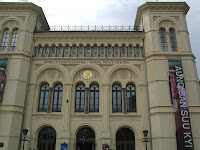 |
| Original Sculpture on Oslo Cathedral |
On our first day in Oslo we went to look at the Oslo Cathedral as it was close to where we were staying. The Cathedral was consecrated in 1697. The pulpit was completed in 1699 followed by the altarpiece in 1700. Other interesting features such as the baptismal font, organ facade and the Royal gallery were built in the early 18th century. The beautiful stained glass windows were created in the 1900’s. In 1930 a silver altar by Arrigo Minerbi was installed at the side. There have been many restorations of the church over the years the last being in 2010. The cathedral is an elegant building with little outside adornment, but there are a few of the original sculptures found placed on the outside walls.
After the short visit to the Cathedral we decided to go to the National Gallery. We knew that would take international and local artists. There are some beautiful landscapes especially from the 1800’s such as Harald Sohlberg’s Winter Night in Rondane. There is a whole room of Munch’s work, which includes The Scream (which was stolen a number of years ago and obviously been recovered) Munch a number of versions of this painting.
There was also an exhibition of Christian Krohg’s works and presented some of the main themes from his most important period as an artist, 1880-90. He saw art as a vehicle to enhance public debate rather than just as decoration in the homes of the upper class. His work Albertine to see the Police Surgeon put a current affair on the art agenda and engage the audience in a social issue. This was a very thought provoking exhibition.
I always find it interesting to discover painters from other countries which don’t always feature in art history books.
We managed to spend number of hours looking at the paintings. I find the smaller galleries like this more satisfying than the really large ones which can be overwhelming.
 |
| Royal Palace |
As it wasn’t too late we decided to walk up to the palace which wasn’t very far away from the gallery. They seemed to be having ‘renovations’done at the palace which made the visitors entrance difficult to find. We had to have a guided tour but had missed the English one but could go on the next one and were told we would be given the tour information in English, which we could read.
The Royal Palace was commissioned by the Swedish King Carl Johan and built between 1825 and 1848. King Hakon VII moved in when he arrived in Norway in 1905 and it still is the official residence of the reigning monarch. On the tour we visited the ballroom, chambers used for the Council of State meetings, the formal reception room known for its frescoes of birds, the banquet hall and a number of other public rooms. The park around the palace is extensive and is open all year. The changing of the guard ceremonies occur throughout the day and are more informal and lack the theatrics we have seen elsewhere.
The next day we decided to take advantage of the tour of the Parliament. Storting, Norway’s national assembly was constituted at Eidsvoll in 1814 but its roots are far older as far back as King Magnus Lagabøte (the Lawmaker) 1263-80 who had the existing body of law put into writing and in 1274 this compilation of codified law was applied throughout the realm and remained in force until 1660.
In 1807 the Scandinavian countries were swept up in the Napoleonic Wars with the countries taking opposing sides which affected the Union of Denmark and Norway. In 1813 the Danish Crown Prince came to Norway as vice-regent. He refused to accept the Treaty of Kiel which ceded Norway to Sweden. In 1814 he called together influential men in Norway with the purpose of discussing Norway’s future. From this meeting a liberal constitution was formulated.
 |
| The Storting Chamber |
Like Sweden it is a one chamber parliament and has a system of proportional representation, elected members sit according to the area they represent not in party grouping. The President is proposed then elected by members of Parliament. Committees are formed to discuss issues. Parliamentary behavior is strictly controlled. No calling out, cat calls, clapping or bad language, which seems highly civilized compared with our bear pit.
The building itself was completed in 1866 and the style in an integration of elements derived from Italian and Scandinavian traditions.
We then went to the Nobel Peace Centre which has information about all the winners of the Nobel Peace Prize. There was also information about Alfred Nobel, was a ‘renaissance’ man with interests and learning in a wide range of fields. He is known mainly for his invention of dynamite from which he made his fortune even though he never actually studied chemistry at university. Though his many other patents were not successful.
 |
| The Nobel Peace Centre |
The Nobel Peace Centre had two temporary exhibitions one featuring women in Afghanistan, Veiled Rebellion and the other Infidel photos by Tim Hethrington on US soldiers Korengal Valley in Afghanistan.
There was also a number of very interesting books in the bookshop.
From a very sobering experience we went off to Arkhus Slot, it was 4.00pm and we thought it would be open until 5, no it was closed. That is one thing very interesting in Norway we found a number of museums and attractions open late and close early. I can understand this in winter, but in summer!
No comments:
Post a Comment